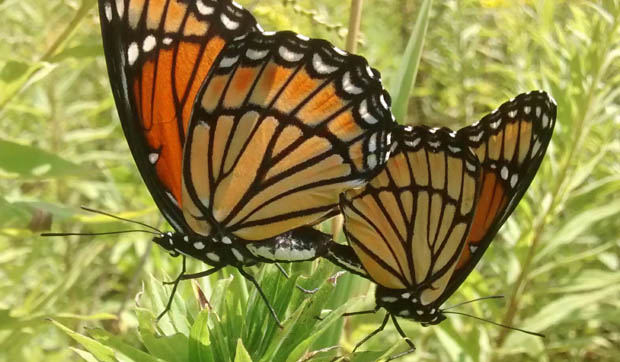Do you see monarchs mating? Look again! These two butterflies are viceroys, distinguished from monarchs by the dark line across the hindwing. Look for this species in moist areas where willows grow.
Viceroy Butterfly
September 22, 2017
A couple of weeks ago we took a look at the current darling of the butterfly world, the monarch, Danaus plexippus. It is in the midst of some trials and tribulations, but also has legions of supporters helping it stage a comeback.
This week, though, I’d like to introduce you to another very similar, yet distantly related cousin to the monarch, the viceroy, Limenitis archippus. Often mistaken for one another, the two actually lead very different lives.
The monarch, as we’ve learned, incorporates migration into its fascinating life cycle. Right now the so-called super generation is preparing to make a migration of thousands of miles to the mountainous fir forests outside Mexico City. Meanwhile, the viceroys are preparing to hunker down and ride out our Midwest winter.
Now, even if we have the mild winter the forecasters are predicting, don’t expect to see viceroys fluttering by. Their overwintering strategy is to hatch from an egg, grow a wee little bit as a larva, then snuggle up inside a willow leaf and enter the stage of insect hibernation known as diapause. They’ll remain in that state until the daylight periods start to lengthen and temperatures start to warm, usually in late April or May.
So even though that’s a really cool strategy that’s interesting in its own right, there’s even more amazingness to the viceroy’s life story. Their likeness to monarchs is more than just coincidence. It’s part of a survival strategy known as mimicry.
Open any entomology book dating back to the 1970s or before and you’ll read that viceroys are the safer-to-consume of the two species because they lack the cardiac glycosides, or toxic heart chemicals, that many monarch acquire by eating milkweed. The books describe how the two types of butterflies exhibit Batesian mimicry, the phenomenon whereby one nontoxic species evolves to look like another toxic species in order to avoid predation.
But-and it always seems like there’s a but when it comes to nature-the story isn’t quite that simple. As it turns out, viceroys aren’t that tasty after all. More recent studies have shown that the species can be just as unpalatable, and potentially dangerous to consume, as monarchs.
Viceroy caterpillars’ main food supply is willow leaves, and willow is a plant that is rich in aspirin-like compounds. As we know, a little aspirin can be a good thing, but too much causes lots of problems. So, really, viceroys are potentially as problematic to predators as monarchs are.
Instead of Batesian mimicry, monarchs and viceroys are examples of Mullerian mimicry. Without getting too complicated, the definition of this form of imitation describes two toxic species mimicking each other, thus enjoying double the protection from predators.
To complicate things just a little bit further, some milkweed plants don’t produce toxins, so the caterpillars that feed on them aren’t toxic at all. They retain this non-toxicity into adulthood.
I’ve not actually witnessed any type of wildlife predator going after a monarch or a viceroy, but have seen a fair share of monarchs with bird bill-shaped chunks missing from their wings. And I also, many years ago, watched my baby brother eat a dead monarch I’d pinned as part of an insect collection. Was it the orange color that attracted him to the butterfly? Was it scientific research? The world may never know. But, for the record, he’s pushing 49 and seems just fine.
(For the curious, Batesian mimicry is named for the 19th century British naturalist Henry Walter Bates. Mullerian mimicry is named for Johann Friedrich Theodor “Fritz” Muller, a German naturalist of the same time period. Both men spent considerable time in Brazil, and formed their theories while watching butterflies.)
Pam Erickson Otto is the manager of nature programs and interpretive services at the Hickory Knolls Discovery Center, a facility of the St. Charles Park District. She can be reached at 630-513-4346 or potto@stcparks.org.

